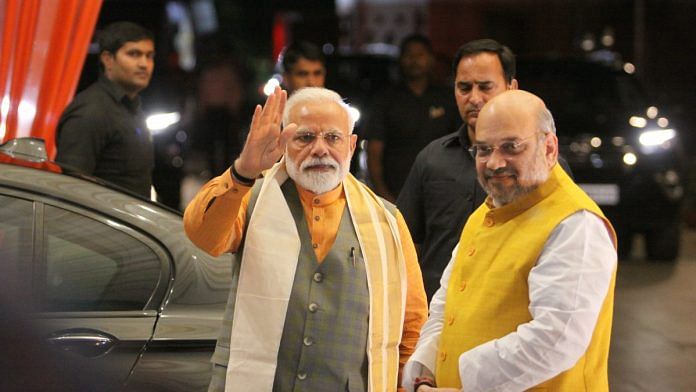The biggest mistake political leaders can make after winning an election is misreading the mandate. Narendra Modi and Amit Shah did that with their victory in the general elections of 2014. Its consequences have manifested in the downturn in their fortunes lately, now highlighted by Bihar.
The BJP leadership misread the 2014 verdict to be an endorsement of RSS-style Hindutva nationalism and social conservatism. It was also seen to be a vote for a tougher, even authoritarian style of governance as people were fed up of UPA-2’s waffling. Third, and most erroneously, the victory, particularly the near-sweep in Uttar Pradesh was seen to be an affirmation that polarisation plays in India. That if you can make the Hindus fear the Muslims enough, their votes will coalesce and thus the majority will always win in such a division. This is the very definition of majoritarianism.
Similar politics had been working in Gujarat for nearly two decades. It seemed to have worked in Uttar Pradesh in 2014 too. Why wouldn’t it work in Bihar now?
Then answer comes from the voter in Bihar. Bihar is not Gujarat. Truth to tell, no other state in India is, except, though to a lesser extent, Maharashtra. No other state in India harbours suspicion of the Muslim and the paranoia for Pakistan you see in Gujarat. I have tried analysing it in the past, but have never been able to do so convincingly. I have seen it first-hand though, and to my cost.
Also read: NDA is sacrificial horse as Modi-Shah complete their Ashwamedha & redefine Indian politics
In 1992, on the first day of Navratri, I launched the Gujarati edition of India Today magazine. I was then, besides being Senior Editor at the English magazine, also publisher of its international and multiple language editions. Entry into the Gujarati magazine market was exciting as it was my first launch. Incidentally, that is when I first met Narendra Modi, then a party worker in a modest one-room abode. We were introduced by Sheela Bhatt, the first editor of the Gujarati edition.
The edition did brilliantly within weeks and we were closing in on the one-lakh mark. Then we were barely in our sixth issue (India Today was fortnightly then), Babri Masjid happened. We took a very firm, secular and constitutional stand on it. Our English cover headline was, Nation’s Shame. Gujarati, was an exact translation, “shame” becoming “kalank”.
The marketing head, Deepak Shourie, warned us against this. He said Gujaratis would never accept this. We stuck to our editorial view and decided we were not going to finesse our fundamental views to suit a market. He was proven right. The issue led to a tsunami of protests. These were still pre-internet days, but my desk was flooded with letters calling us “Pakistan Today” and “Islam Today” etc. Within the following month, the sales had fallen by 75 per cent. The edition never recovered and had to be shut down a few years later. This, mind you, was years before the rise of Modi. Congress was still in power in Gujarat, so please do not blame Modi or Moditva. This was the Gujarati public opinion.
Why is it so, I have never been able to answer. Some of my scholarly Gujarati friends point to the long history of Muslim invasions, serial sackings of the Somnath Temple. Some even noted that while, despite being a border state Gujarat never saw much fighting, it was witness to two serious setbacks. The first, the Kutch conflict of early 1965, in which India performed indifferently and had to agree to a humiliating ceasefire (territory ceded was recaptured in 1971) and second, the tragic shooting down of the state government’s official Dakota, carrying then Chief Minister Balwant Rai Mehta by a Pakistani Sabre during the Sept, 1965 war. Mehta, very popular then, is the only serious public figure to lose his life in a conflict in our independent history. But all these look distant and don’t really explain the Gujarati sentiment.
I am not losing my way, I am returning to my central argument. Which is that while I may not be able to explain why Gujarat thinks the way it does, the rest of the country doesn’t. The same editorial view and headline that sank our Gujarati edition post-Ayodhya made the sales of our much bigger Hindi edition zoom in the entire heartland. This, of course, included Bihar.
If what is rejected so overwhelmingly by Gujarat is welcomed by the heartland, it follows that what sells there may be rejected here. The Uttar Pradesh sweep of 2014 was because the youth saw a new hope in Modi’s promise of growth and decisive governance. It wasn’t a vote against Muslims or Pakistan. It reversed in Bihar because voters saw Nitish make the same positive, constructive appeal while the BJP tried to scare them of Muslims, Pakistan, terrorism or to rouse them to protect the cow.
Our conclusion, therefore: The Gujarat model of growth won Narendra Modi the 2014 election. Because the BJP read that verdict wrongly, it is bringing the Gujarat model of polarisation elsewhere in India. No surprise then that Bihar has rejected it.
Also read: Partners dispensable in Modi-Shah construct if they do not bring additional votes



